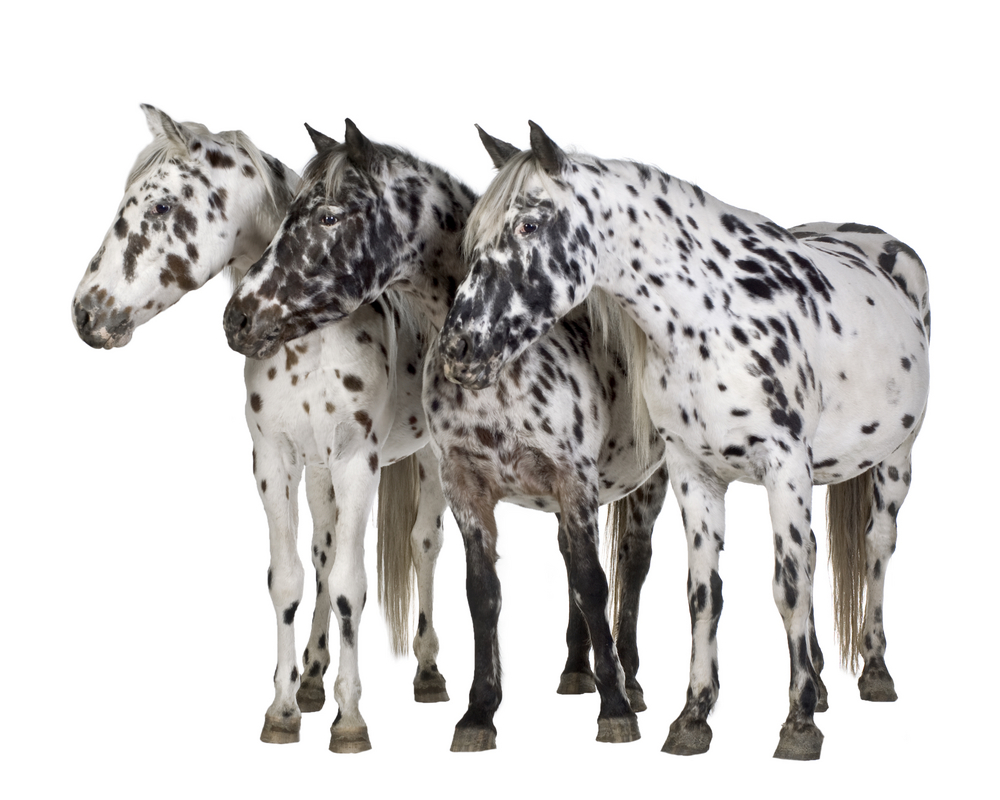Quick Summary

Click here for Price and Turnaround Time
Phenotype: Leopard complex or appaloosa spotting is a white coat pattern characterized by variable patterning with or without pigmented spots known as leopard spots. This pattern is also characterized by mottled skin, stripped hooves, white sclera, and progressive loss of pigment in the coat (also known as roaning) with age. Horses homozygous for leopard complex (LP/LP) also have congenital stationary night blindness (CSNB), or the inability to see in low-light conditions.
Mode of Inheritance: Incomplete dominance
Alleles: N = Normal or non-leopard complex, LP = Leopard complex/Appaloosa spotting
Breeds appropriate for testing: Appaloosa, British Spotted Pony, Australian Spotted Pony, Knabstrupper, Noriker, Miniature Horse, Pony of the Americas, among others
Explanation of Results:
- Horses with N/N genotype will not have a leopard complex spotting pattern and cannot transmit this variant to their offspring.
- Horses with N/LP genotype will have a variable white pattern with pigmented spots. The size of the white pattern depends on what patterning modifiers are also present. They may transmit a leopard complex spotting variant to 50% of their offspring. Matings with N/N genotype will result in a 50% chance of producing a foal with leopard complex/appaloosa spotting. N/LP horses are not night blind but they can pass on the trait to their offspring.
- Horses with LP/LP genotype will have minimal to extensive white pattern with few to no pigmented spots. The size of the pattern is dependent on the modifiers present. Horses with this genotype will also have congenital stationary night blindness (CSNB) and are at elevated risk for equine recurrent uveitis (ERU). They will transmit a leopard complex spotting variant to all of their offspring. Matings with any genotype are predicted to produce foals with leopard complex spotting.
Expression of Leopard Complex is variable and white patterning may not be present in all horses that inherit the LP allele, but those with LP will progressively lose pigment as they age.
White Pattern Panel 2
$85 per animal
Appaloosa Panel 1
$65 per animal
Appaloosa Panel 2
$50 per animal
Full Color/Pattern Panel
$155 per animal
Sample Collection
Horse DNA tests are carried out using cells from the roots of a hair sample (roughly 20-40 hairs).
1. Grab about 10 hairs at the base.
2. Wrap the hairs around your finger and give it a quick pull.
3. Check the ends to make sure the pulled hairs have roots.
4. Repeat the process until you have collected about 20-40 hairs with intact roots.
5. You can choose different places on the mane or tail. NOTE: For foals, we recommend pulling all hairs from the tail only.
6. Tape the hairs to the submission form and fold the form along the dotted line to protect the sample. Do not use ziploc bags as they can cause condensation that allows mold to grow on the hair.
7. Place the folded form containing the sample in a paper envelope and mail it to the laboratory.
A popular source of symmetric white patterning called leopard complex spotting (LP), also known as Appaloosa spotting, is characteristic of the Appaloosa and Pony of the Americas breeds. Other breeds around the world that exhibit this pattern include the British Spotted Pony, Knabstrupper, Noriker, and Tannu Tuva Pony. Leopard complex is also found at a lower frequency in the American Miniature Horse and Spanish Mustang breeds. In addition to a white pattern, the expression of leopard complex includes several components: mottled skin around the muzzle, anus, genitalia, and eyes, stripped hooves, easily visible sclera (white of the eye) and progressive roaning, or loss of pigment, in the pigmented areas of the coat with age. The range of the white pattern can vary from minimal at birth to a horse that is almost completely white. The variability in the pattern is due to the interplay of multiple genes. Pigmented spots, known as leopard spots, can occur in white pattern areas.
The mutation responsible for LP is a large insertion of an extra 1378 bp in the calcium ion channel gene TRPM1. LP is inherited as an incompletely dominant trait meaning the phenotype is different in horses with one or two copies of the LP variant. Horses with two copies LP/LP will have little to no leopard spots while those with one copy (N/LP) have pigmented spots in their white patterned area. The amount of white however is not dosage related, such that homozygous horses can have minimal expression of white patterning in the same manner that heterozygotes do. The variability in the amount of white on leopard complex patterned horses is controlled by other genes, one of which is PATN1.
Horses that are homozygous for leopard complex also have congenital stationary night blindness (CSNB), which is the inability to see in low light conditions. Horses are born with this condition and it does not appear to progress or get worse with age. However, horses with two copies of LP were recently shown to be at an elevated risk for equine recurrent uveitis (ERU) which is a progressive condition and the leading cause of blindness in horses. Research at the VGL and in collaboration with specialists around the world is focused on determining the role of LP in ERU risk.
TRPM1 has been shown to play an important role in the cell signaling that enables night vision. Therefore, the LP insertion in TRPM1 disrupts the normal function of this gene causing the inability to see in low light conditions. The precise role this insertion plays in disrupting pigmentation causing LP patterning and in the immune response that contributes to ERU is not well characterized.
Testing for leopard complex/appaloosa spotting can help breeders, owners, and clinicians identify homozygous animals (animals with 2 copies of the variant). Horses homozygous for the LP variant will always produce offspring with leopard complex spotting patterns. Utilization of this test can help to inform management decisions for both CSNB and ERU.
